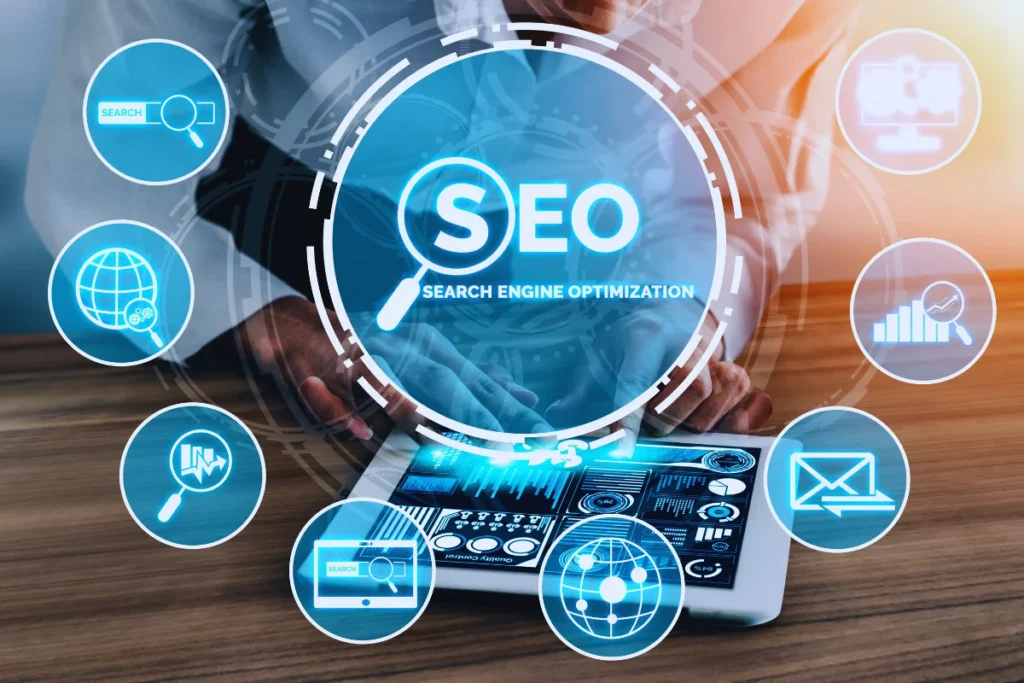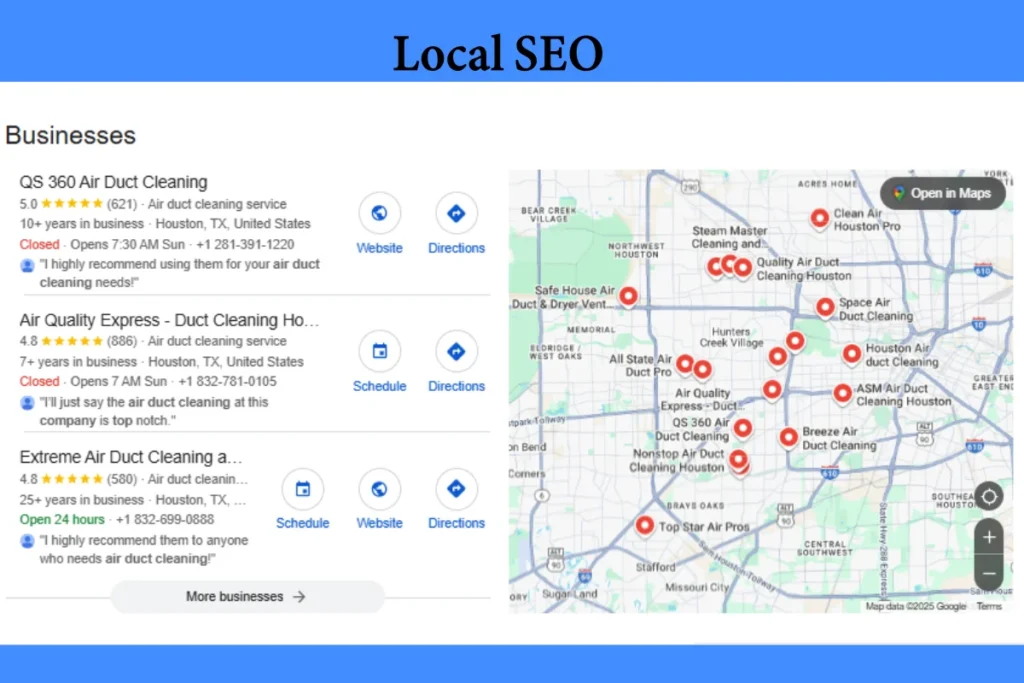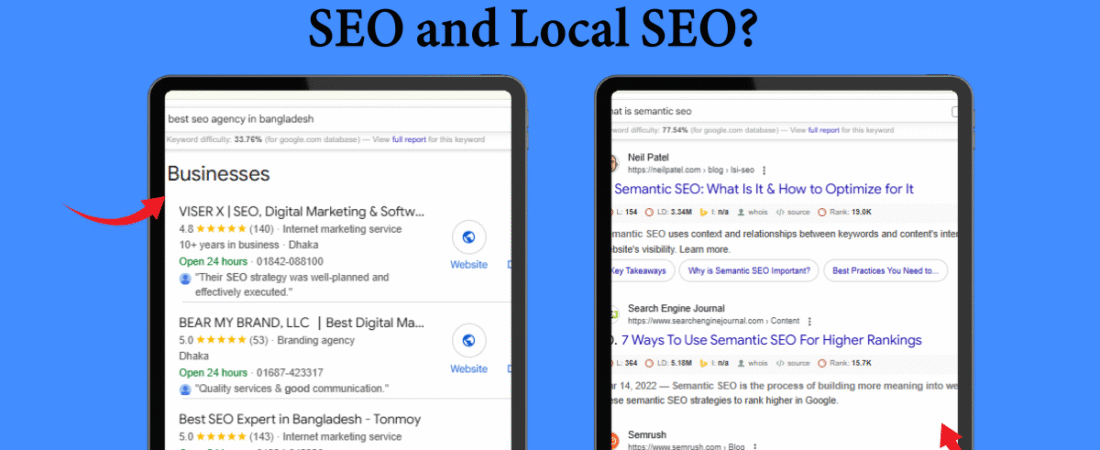Search Engine Optimization, also known as SEO, is the process of improving a website so it can appear higher in search engine results. It helps businesses reach more people online by making their content easier to find.
Local SEO, on the other hand, focuses on promoting a business to people in a specific location. For example, if someone searches for “coffee shop near me,” local SEO helps a nearby coffee shop show up in those results.
Understanding the difference between SEO and Local SEO is very important for businesses. While SEO can bring visitors from all over the world, Local SEO helps attract nearby customers who are ready to buy or visit. Knowing when to use each strategy can make a big difference in growth and visibility.
What is SEO?
SEO stands for Search Engine Optimization. It is the process of improving a website so it can rank higher in search engine results like Google, Bing, or Yahoo. The main goal of SEO is to bring more visitors to a website without paying for ads. These visitors are called organic traffic.

SEO works on a global or national level, meaning it helps a website reach people across different cities, countries, or even worldwide. For example, an online clothing store can use SEO to attract customers from many regions instead of just one local area.
Here are some key elements of SEO:
- Keyword Optimization
- Choosing the right keywords for which people are searching.
- Example: If you sell shoes, using keywords like “best running shoes” or “buy sneakers online” can help your website appear in search results.
- Choosing the right keywords for which people are searching.
- On-Page SEO
- Improving website content, titles, meta descriptions, and headings.
- Making sure images and links are optimized for better visibility.
- Improving website content, titles, meta descriptions, and headings.
- Off-Page SEO (Backlinks)
- Building trust and authority by getting other websites to link back to your site.
- High-quality backlinks tell search engines that your website is reliable and valuable.
- Building trust and authority by getting other websites to link back to your site.
- Technical SEO
- Ensuring the website loads fast, is mobile-friendly, and easy for search engines to crawl.
- Fixing errors like broken links or slow page speed.
- Ensuring the website loads fast, is mobile-friendly, and easy for search engines to crawl.
- User Experience
- Creating a website that is simple, clear, and enjoyable for visitors.
- Search engines reward websites that keep users engaged.
- Creating a website that is simple, clear, and enjoyable for visitors.
- Content Creation
- Publishing useful blogs, guides, videos, and product descriptions.
- Fresh and relevant content helps attract and retain visitors.
- Publishing useful blogs, guides, videos, and product descriptions.
SEO isn’t dead—it’s evolving. Explore the changes you need to know about in our complete SEO guide.
What is Local SEO?
Local SEO means optimizing a business so it appears in search results for people in a specific location. In simple terms, it helps businesses show up when someone nearby searches for their products or services. When people type “near me” or search for a shop in their city, Local SEO makes sure the right businesses appear at the top of Google Maps and local search results.

If you are wondering what local seo is, the answer is that it is a strategy designed to connect local customers with nearby businesses. Instead of competing with global websites, Local SEO focuses only on a particular area. This makes it very useful for small and medium-sized businesses that want to attract people close to them.
Here are some important parts of Local SEO:
- Google Business Profile Optimization
- Creating and updating a Google Business Profile (previously Google My Business).
- Adding correct information such as address, phone number, opening hours, and photos.
- This helps businesses appear on Google Maps and in the local pack.
- Creating and updating a Google Business Profile (previously Google My Business).
- Local Keywords
- Using city names, neighborhoods, or “near me” keywords in content.
- Example: “best pizza in New York” or “dentist near me” are local search terms.
- Using city names, neighborhoods, or “near me” keywords in content.
- Online Reviews
- Customer reviews on Google, Yelp, or Facebook build trust.
- Positive ratings help a business rank higher in local results.
- Customer reviews on Google, Yelp, or Facebook build trust.
- Local Citations
- Listing the business name, address, and phone number in local directories.
- Examples include Yellow Pages, TripAdvisor, or city-specific websites.
- Listing the business name, address, and phone number in local directories.
- Mobile-Friendly Experience
- Most local searches happen on mobile phones.
- A fast, mobile-friendly site ensures customers can find information quickly.
- Most local searches happen on mobile phones.
- Local Content Creation
- Writing blogs or posts about local events, news, or city guides.
- Example: A restaurant in Chicago could post about “Top 5 Foods to Try in Chicago.”
- Writing blogs or posts about local events, news, or city guides.
Local SEO is especially important for service providers, restaurants, hotels, gyms, real estate agencies, clinics, and retail shops. It helps them bring in customers who are already nearby and ready to make a purchase.
SEO vs Local SEO: The Key Differences
SEO and Local SEO are both important parts of digital marketing, but they serve different purposes. SEO focuses on reaching a wide audience on a national or global scale, while Local SEO connects businesses with customers in a specific city or neighborhood. Understanding these differences helps businesses choose the right strategy for their goals.
Here is a clear comparison of the main differences:
| Factor | SEO (Global/National) | Local SEO (Local Area) |
| Target Audience | Global or national visitors | Local customers in a specific city or area |
| Keywords | General keywords like “digital marketing” | Geo-targeted keywords like “digital marketing in New York” |
| Search Results | Organic search results across the web | SEO local results like Google Maps and local pack |
| Goal | Build brand visibility everywhere | Increase local sales and foot traffic |
Examples in action:
- SEO: An online course platform teaching students worldwide would use SEO to reach learners in multiple countries.
- Local SEO: A restaurant in London would use Local SEO to appear for searches like “best restaurant in London” or “restaurant near me.”
Both strategies are powerful, but the choice depends on whether a business wants to reach a global audience or focus on nearby customers. Using the right approach ensures better visibility, more traffic, and higher sales.
“What Does LLM Stand For in SEO? Discover how it fits into our SEO tips and strategies to improve website performance.”
Local SEO vs Traditional SEO
When people talk about traditional SEO, they usually mean the broader method of optimizing a website for general search results. Traditional SEO helps websites rank for keywords that can attract visitors from different cities, countries, or even worldwide. It is not focused on one location but on overall online visibility.
Local SEO is different because it helps a business appear in local search results such as Google Maps and the local pack. It is built to connect a business with nearby customers who are searching for services or products in their city. This makes Local SEO very useful for shops, restaurants, gyms, clinics, and other local service providers.
Here are the main differences between Local SEO and Traditional SEO:
| Factor | Traditional SEO (General SEO) | Local SEO (Location-Based SEO) |
| Target Area | National or global audience | Specific city, town, or neighborhood |
| Keywords | General keywords like “best shoes online” | Geo-targeted keywords like “best shoes in Dhaka” |
| Ranking Focus | Organic results across the web | SEO local results like Google Maps and local 3-pack |
| Google Business | Not a major focus | High focus on Google Business Profile optimization |
| Reviews & Citations | Relies more on backlinks and content | Relies on customer reviews and local business listings |
| Goal | Build brand visibility everywhere | Drive foot traffic, phone calls, and local leads |
Examples:
- Traditional SEO works best for an online clothing store that ships products worldwide.
- Local SEO works best for a restaurant in London that needs to appear when someone searches “best restaurant in London” or “restaurant near me.”
Both are valuable, but businesses must choose the right strategy depending on whether they want global reach or strong local visibility.
Local SEO vs Global SEO
Global SEO is a strategy that helps websites reach people across multiple countries and languages. It is designed for businesses that want to attract customers worldwide or in several regions. This often includes multi-language websites, international keywords, and strategies to compete in large markets. For example, an e-commerce business that ships globally would use global SEO to reach buyers in many countries.
Local SEO focuses on a specific city, town, or region. It helps businesses appear in local search results and on Google Maps when someone searches for nearby services or products. For example, a dentist in Dhaka only needs patients from that city.
Here is a clear comparison table:
| Factor | Global SEO (International) | Local SEO (Location-Based) |
| Target Audience | People across multiple countries and regions | Customers in a specific city, town, or area |
| Keywords | General and international keywords | Geo-specific keywords like “near me” searches |
| Website Setup | Multi-language pages, country-specific content, currency options | Local landing pages, Google Business Profile optimization |
| Search Results | Organic rankings in global or national searches | Local search results and Google Maps |
| Competition Level | High competition from global businesses | Lower competition, focused on one location |
| Examples | Online clothing store shipping worldwide | Restaurant or dentist in one city |
Examples in action:
- Global SEO: An online electronics store in the USA targeting buyers in Europe, Asia, and Africa.
- Local SEO: A bakery in London appears for “best bakery near me” or “London bakery.”
- In short, global SEO helps businesses expand internationally, while local SEO focuses on connecting with nearby customers. Many businesses use both strategies to reach local clients and a wider audience simultaneously.
Why Businesses Need Both
Many businesses can get the best results by using both SEO and Local SEO. Each has its own strengths, and combining them can help reach more customers.
1. Businesses that benefit more from Local SEO
Local SEO works best for businesses that want customers nearby. Examples include:
- Restaurants and cafes: Appear in searches like “restaurant near me.”
- Salons and spas: Attract people looking for services in the city.
- Shops and boutiques: Bring more local foot traffic.
- Clinics and dentists: Help patients find services nearby.
2. Businesses that benefit more from regular SEO
Regular SEO is useful for businesses that target a wider audience. Examples include:
- Online stores: Reach customers across the country or world.
- Blogs and websites: Attract readers globally.
- Software companies: Find users in multiple regions.
3. Businesses that can use both
Some businesses can grow more by combining Local SEO and regular SEO:
- A restaurant chain can use Local SEO for each branch and regular SEO for delivery services or recipes.
- A retail brand can attract local shoppers and online buyers at the same time.
- A real estate agency can use Local SEO for city-specific listings and global SEO to reach investors.
Using both SEO and Local SEO together gives businesses the best chance to grow. It helps reach nearby customers while also attracting people from further away.
Final Thoughts
Understanding the difference between SEO and Local SEO is essential for businesses that want to grow online. Each strategy serves a different purpose, and choosing the right one can improve visibility, attract more customers, and increase sales.
Key Points to Remember:
- SEO helps businesses reach a global or national audience using general keywords and organic search results.
- Local SEO focuses on customers in a specific city or area, using geo-targeted keywords, Google Maps, local listings, and customer reviews.
- Different Businesses, Different Needs: Some businesses benefit more from SEO, some more from Local SEO, and some do best by combining both strategies.
- Choosing the Right Strategy: Focus on Local SEO if you want to attract nearby customers quickly. Focus on SEO if your goal is to reach people across cities, countries, or worldwide.
- Combine for Maximum Impact: Many businesses use both to grow locally and globally, increasing traffic, leads, and sales.
- Professional Help: Hiring SEO experts can help you optimize your website, create high-quality content, and implement strategies that bring the best results.
By understanding and applying the right SEO strategies, businesses can improve their online presence, connect with the right audience, and achieve long-term growth.
Frequently Asked Questions (FAQs)
What is the main difference between SEO and Local SEO?
SEO focuses on improving a website’s visibility on a national or global scale, while Local SEO targets customers in a specific city or region. Local SEO helps businesses appear in Google Maps and local search results.
Which businesses need Local SEO?
Local SEO is ideal for businesses that rely on nearby customers, such as restaurants, salons, clinics, gyms, and retail shops. It helps attract people who are ready to visit or buy locally.
Can a business use both SEO and Local SEO?
Yes. Many businesses use both strategies. For example, a restaurant chain can use Local SEO for each location and regular SEO for online delivery or blog content. Combining both strategies can increase visibility and reach.
What are the key elements of SEO?
SEO includes keyword optimization, on-page content, backlinks, technical SEO, user experience, and high-quality content creation. It is designed to attract visitors from national or global searches.
What are the key elements of Local SEO?
Local SEO focuses on Google Business Profile optimization, geo-targeted keywords, local citations, online reviews, mobile-friendly websites, and location-specific content.
Does Local SEO help small businesses grow faster?
Yes. Local SEO connects businesses with customers nearby who are ready to make a purchase or visit. This can lead to more foot traffic, calls, and local leads quickly.
How can I choose between SEO and Local SEO?
Consider your business goals and audience. If you want customers from multiple regions or countries, focus on SEO. If your goal is to attract people from a specific city or neighborhood, focus on Local SEO. Many businesses benefit from using both.
Is hiring an SEO professional necessary?
While some businesses can manage SEO themselves, hiring a professional ensures your website is optimized correctly, saves time, and delivers better results in both SEO and Local SEO.
{ “@context”: “https://schema.org”, “@type”: “BlogPosting”, “mainEntityOfPage”: { “@type”: “WebPage”, “@id”: “https://www.example.com/seo-vs-local-seo” }, “headline”: “What is the Difference Between SEO and Local SEO”, “description”: “Learn the key differences between SEO and Local SEO, how each strategy works, and which businesses benefit from them. Understand SEO vs Local SEO with clear examples and FAQs.”, “image”: “https://www.example.com/images/seo-vs-local-seo.jpg”, “author”: { “@type”: “Person”, “name”: “Habiba Binta Hafij” }, “publisher”: { “@type”: “Organization”, “name”: “Your Website Name”, “logo”: { “@type”: “ImageObject”, “url”: “https://www.example.com/images/logo.png” } }, “datePublished”: “2025-09-27”, “dateModified”: “2025-09-27”, “articleBody”: “This blog explains the differences between SEO and Local SEO, key benefits, strategies for different business types, and actionable tips for using both effectively.”, “mainEntity”: [ { “@type”: “Question”, “name”: “What is the main difference between SEO and Local SEO?”, “acceptedAnswer”: { “@type”: “Answer”, “text”: “SEO focuses on improving a website’s visibility on a national or global scale, while Local SEO targets customers in a specific city or region and helps businesses appear in Google Maps and local search results.” } }, { “@type”: “Question”, “name”: “Which businesses need Local SEO?”, “acceptedAnswer”: { “@type”: “Answer”, “text”: “Local SEO is ideal for businesses that rely on nearby customers, such as restaurants, salons, clinics, gyms, and retail shops. It helps attract people who are ready to visit or buy locally.” } }, { “@type”: “Question”, “name”: “Can a business use both SEO and Local SEO?”, “acceptedAnswer”: { “@type”: “Answer”, “text”: “Yes. Many businesses use both strategies. For example, a restaurant chain can use Local SEO for each location and regular SEO for online delivery or blog content. Combining both strategies increases visibility and reach.” } }, { “@type”: “Question”, “name”: “What are the key elements of SEO?”, “acceptedAnswer”: { “@type”: “Answer”, “text”: “SEO includes keyword optimization, on-page content, backlinks, technical SEO, user experience, and high-quality content creation. It attracts visitors from national or global searches.” } }, { “@type”: “Question”, “name”: “What are the key elements of Local SEO?”, “acceptedAnswer”: { “@type”: “Answer”, “text”: “Local SEO focuses on Google Business Profile optimization, geo-targeted keywords, local citations, online reviews, mobile-friendly websites, and location-specific content.” } } ] }